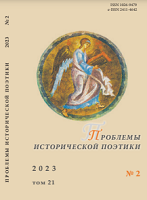Образы Гиляна в поэтике Велимира Хлебникова
Images of Gilan in the Poetics of Velimir Khlebnikov
Author(s): Oksana A. Kravchenko, Alina A. Shuldishova, Zeinab Sadeghi SahlabadSubject(s): Studies of Literature, Russian Literature
Published by: Петрозаводский государственный университет
Keywords: Khlebnikov; Asia; Iran; Gilan; Miturich; Easter; poetics of space; landscape; image; Russian-Iranian literary relations;
Summary/Abstract: The article discusses V. Khlebnikov’s Iranian images associated with the poet’s stay in Gilan from April to July 1921. The relevance of the article is determined by the need to explore the Persian component of Khlebnikov’s poetics, which cannot be reduced to speculative and generalized Asian images. The article demonstrates the diversity of poetic manifestations of Gilan, depicted through its inhabitants, landscapes, mythology, ancient and contemporary history. The poem “Night in Persia” is proposed to be read as a spiritual experience of mastering space. The specifics of female images in the poems “Novruz of Labor,” “With a Copper Womb…” as well as the images of Gilan’s nobility in the poem “Gul-Mulla’s Trumpet” are analyzed. Gilan images made it possible to concretize the poet’s ideas about the unity of universal destiny. For the first time, the variants of the essay “The Iron Pen on the Willow Branch” are brought into discussion on the Eastern theme in Khlebnikov’s works. The simultaneous semantic connotations of the willow tree as a writing tool and a Christian symbol are defined. The composition of the essay recreates the logic of sacred history: from Palm Sunday to Easter. The tragic death of Gilan’s political leader Kuchuk-Khan is correlated with the idea of sacrificial love embodied in the avant-garde work of the artist P. Miturich. Thus, the poet contrasts the forced liberation of the East with its spiritual transformation through the efforts of poets and artists. The images of Gilan embody the poet’s ideas about the nature of Iranian influences and reflect the direct Persian impact on Russian literature, effectively expanding its boundaries.
Journal: Проблемы исторической поэтики
- Issue Year: 21/2023
- Issue No: 2
- Page Range: 196-216
- Page Count: 21
- Language: Russian

